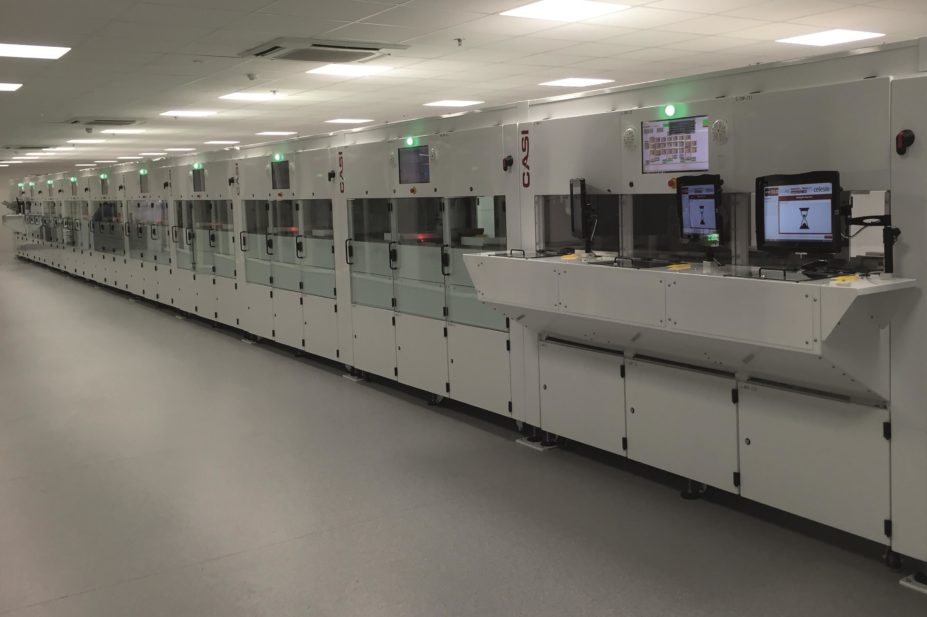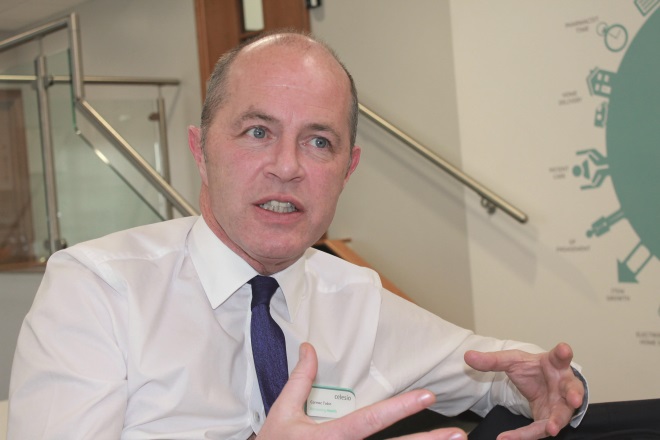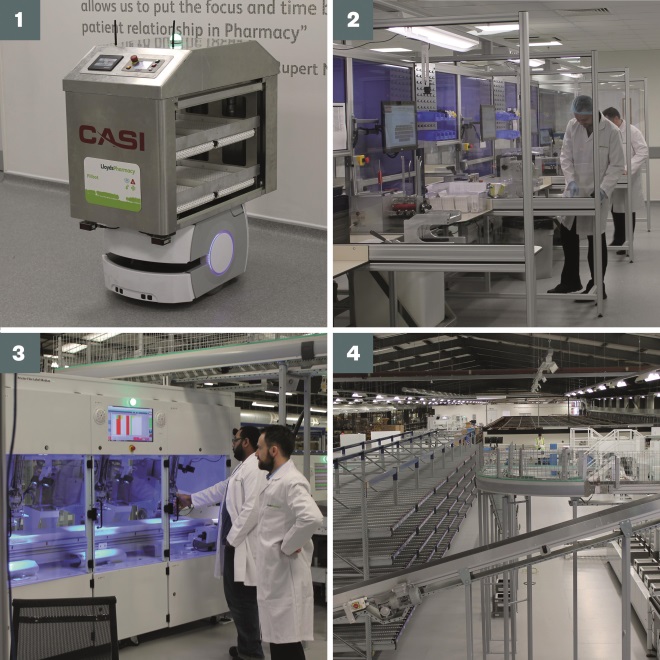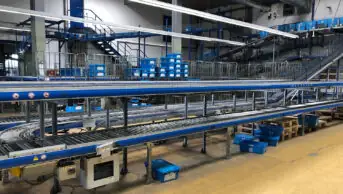
Suzanne Elvidge
An island of gleaming white surfaces is suspended high above a busy distribution centre. A four-wheeled waist-high robot, a shiny and silent shuttered box, moves by itself to a hatch where a conveyer belt delivers freshly filled cartridges of drugs. Once full, the robot delivers its payload to a filling line, where robotic arms pick and drop individual tablets and capsules precisely into waiting trays. Followed by technicians watching its initial voyage, the robot returns to wait for its next instructions or takes itself to its charging point.
At another line of white, metalclad stations, packets of drugs are identified, picked by robotic arms, individually labelled and placed into bags along with the completed trays. Human operators, white-coated, move around the machines, watching the drugs move along the lines, checking computer screens filled with figures and images of drugs with a quiet tension as glitches are gradually ironed out. Every now and then a box of tablets is spat out by the system because of a label that’s askew, or an unrecognised code, and these are validated and added manually into the patient’s individual totes.
“Products are scanned in by batch and we take photographs throughout the assembly process,” explains Cormac Tobin, Celesio UK’s managing director, as he walks along one of the world’s first fully automated prescription assembly lines in their facility in Warrington in the north east of England. “We can track individual tablets down to specific pockets.”

Source: Suzanne Elvidge
Cormac Tobin, Celesio UK’s managing director, says their Warrington facility is for prescription assembly, not offsite dispensing, since it is the pharmacists at the spoke that dispense the drugs
Although the assembly line is effectively beta testing, the robotic arms are already fulfilling prescriptions for a handful of pharmacies in the north of England. At full tilt, the assembly line should be able to fill a monitored dosage system (MDS) tray, on average, every five seconds, or 12 trays per minute, rather than the seven or eight an hour with the manual systems. Celesio, the parent company to the wholesaler and distributor AAH Pharmaceuticals and pharmacy chain Lloydspharmacy, has been supplying 228 pharmacies, or ‘spokes’, from four hubs for almost a decade. As the automated hub becomes established, it will gradually replace the existing prescription assembly process at the Warrington site.
‘Hub-and-spoke’ dispensing has the potential to bring benefits to both pharmacists and patients by releasing capacity, increasing efficiencies and by cutting out errors, according to those who contend that the burgeoning technology should be rolled out across the pharmacy sector. But some in the industry question whether these benefits are real and argue that hub-and-spoke dispensing is beset by challenges.
“The hub-and-spoke models are complex,” says Michael Hewitson, a superintendent pharmacist of an independent pharmacy. Hewitson chairs a working group established by the National Pharmacy Association (NPA), a member organisation for independent community pharmacies, to consider the impact of hub-and-spoke dispensing. “There is little published information available about the potential outcomes, and I have seen no evidence so far to back up the claims that hub and spoke will reduce operating costs.”
Terms and conditions
The debate around automated dispensing processes has been hampered by confusion over some of the terms involved[1]
— namely ‘hub-and-spoke’ and ‘centralised’ dispensing. In hub-and-spoke dispensing, prescriptions come into the spoke pharmacy and are sent electronically to the hub, where they are assembled and then returned to the spoke.
“We describe what we do as prescription assembly, not offsite dispensing. We are putting things in bags; it’s the pharmacists at the spoke that dispense the drugs,” says Tobin.
Pharmacists at the spoke retain the relationship with patients, offering support and advice. Hub-and-spoke dispensing relates to repeat prescriptions, including those supplied in MDS trays, and only when these are planned in advance because the process typically has a 48-hour turnaround.
Both the hub and the spoke have a superintendent pharmacist, and are registered pharmacies. While the spokes have NHS contracts, these are not currently required for the hub.
With centralised dispensing, relationships between patients and pharmacists occur at the hub, and may be online rather than face-to-face. Dispensed drugs are picked up from a collection point, or delivered by courier or post. This system could result in fewer opportunities for pharmacists to give patients individualised advice and support, but may have advantages for people who are housebound, or who find interpersonal interactions difficult. Centralised dispensing has been described by Claire Ward, chair of Pharmacy Voice, a body that represents several community pharmacy organisations, as the ‘Amazonisation’ of pharmacy, treating therapeutics as commodities[2]
.
The NPA working group chaired by Hewitson was set up in response to government plans to consult on legislative changes around hub-and-spoke dispensing, a consultation that was launched in March 2016. Currently, only ‘hubs’ and ‘spokes’ that are part of the same business entity can operate a hub-and-spoke system. The government’s proposals would create a “level playing field” by allowing independent pharmacies to participate in hub-and-spoke dispensing through third party agreements.
The NPA’s working group pulled in experts from academia and pharmacies, visited the Celesio hub site in Warrington, and commissioned researchers to carry out an independent literature review looking at UK and international evidence. Finally, it carried out a survey of NPA members, receiving responses from more than 400 people responsible for around 1,000 pharmacies.
As part of its consultation, the government makes a number of assumptions around the efficiencies that might be afforded by hub-and-spoke dispensing. It predicts that if 60% of medicines are dispensed through ‘hub and spoke’ models, there would be a 10% reduction in pharmacist labour costs and a 25% reduction in pharmacy technician labour costs at spoke pharmacies. And there would be increases of between 2.5% and 5% for pharmacist labour costs and between 6.25% and 12.5% for pharmacy technician labour costs at hub pharmacies.
The UK government has suggested that hub-and-spoke dispensing could potentially cover up to two-thirds of England’s dispensing volume – our survey suggested figures of only around a quarter to a third
“The assumption is therefore that ‘hub’ pharmacies are two to four times as efficient (excluding capital investment) as spoke pharmacies,” the consultation document states.
“The UK government has suggested that hub-and-spoke dispensing could potentially cover up to two-thirds of England’s dispensing volume – our survey suggested figures of only around a quarter to a third,” says Hewitson.
Transforming technology
Tobin sees the opportunities presented by hub-and-spoke dispensing as a way to change the role of a pharmacy and improve the way it looks. Moving the assembly of prescriptions to the hub would mean that pharmacies need less space to store drugs, creating more space to see patients and potentially to supply additional services.

Photo guide: Areas of Celesio’s hub and spoke centre
Source: Suzanne Elvidge
1. Celesio’s “Pilbot”, a travelling robot that takes canisters of drugs to the assembly line
2. Dispensers de-blistering pill packs into canisters
3. Dispensers overseeing the labelling of original packs
4. Holding area for all original pack totes
“Pharmacy needs to be relevant – we need to make sure that everything adds value and is patient-centric,” says Tobin. “I see the future of clinical pharmacy combining face-to-face dispensing, click and collect in the pharmacy or in secure lockers opened with an iPhone, home delivery, and discussions on Skype. It’s physical and digital coming together.”
Pharmacies could focus more on providing education and support, and could increase turnover by stocking products that link with their services. As an example, Celesio has launched pilot First Care walk-in clinics in Lloydspharmacy stores, where pharmacists can treat minor ailments and injuries. The pharmacies also sell the products required for self-care after the treatment.
But Hewitson says there is currently only limited capacity for growth in additional services. For example, medicines use reviews (MURs), a service offered under the community pharmacy contract that helps patients get the most benefit from their medicines: the maximum number of MURs for which a pharmacy will be paid in any year is 400; but MURs are already being completed, on average, at a rate of more than 290 per pharmacy per year, says Hewitson.
Tobin acknowledges the limitations but says there is scope for community pharmacies to do more. “There is a lot of potential, such as training staff and carrying out MURs on site in care homes, administering flu and other vaccines, or working with private providers to provide screening. Pharmacists will need to create the opportunities,” he says.
Safety first
Close attention is paid to safety at the new Celesio hub. The system is ‘taught’ to recognise the drugs it is handling, using physical characteristics and image recognition, and an audit trail is created at each stage. The 2D barcodes on original packs are scanned and images are captured at each step of the assembly of MDS trays.
In the Celesio model, the pharmacist at the spoke is responsible for data entry, which may be manual or from a scanned barcode, and its transfer to the hub. The clinical and accuracy checks are carried out on screen, with step-by-step confirmation and cross-checks with previous prescriptions, cautions and contraindications.
Prescriptions are filed at the spoke, and the data remain encrypted all the way to the assembly point. The hub is where assembly takes place: original packets of medicines are automatically picked, labelled, packed and sealed into bags. MDS trays are assembled by machine, with individual tablets packed and sealed, with dosage instructions printed on the back of the tray, and prescribing information printed and included.
The drugs are delivered to the spoke in sealed plastic bags with an opaque bottom for patient privacy and a clear top, allowing a final visual check before the bag is handed over to the patient.
The opportunity for improved safety through the use of automation is something that the Department of Health is keen to promote.
Keith Ridge, NHS England’s chief pharmaceutical officer, told MPs during an evidence session for the All-Party Pharmacy Group’s inquiry into primary and community care that pharmacists have a professional obligation to adopt automated dispensing processes.
“That type of large-scale technology is both safer and more efficient,” he said at Westminster on 16 March 2016.
Ridge said there was evidence from the literature that suggests error rates in community pharmacy in England are far higher than in countries that have adopted automated dispensing.
“With the traditional system approach to dispensing, the error rate in community pharmacy is around 3%,” he said. “In other countries, that rate is much lower: you need several zeros before the decimal place.”

Michael Hewitson, a superintendent pharmacist of an independent pharmacy, says he has seen no evidence that a hub-and-spoke system will reduce operating costs
Hewitson acknowledges that use of automation can increase accuracy but is sceptical about the data cited by Ridge. “The use of these statistics seems highly dubious,” he says. “It sounds like Dr Ridge is comparing the overall risk of your car breaking down versus the risk of one component failing.”
If you ask for the wrong item you will get the wrong item from the robot; this is accurate but not valid
Data input is also critical. As Hewitson explains: “If you ask for the wrong item you will get the wrong item from the robot; this is accurate but not valid.”
Companies with their own automated assembly processes will be able to demand high levels of training and accuracy before allowing staff to use their hub-and-spoke system. Third party hubs will not be able to demand that staff at the independent spokes follow the same procedures, which could introduce risks, according to Hewitson.
Improvements in efficiency could also be used as a way for contractors to reduce costs by cutting down on staff. Hewitson believes this could increase the risk of errors because pharmacists may be required to check their own work because of low staff levels. This could impact on patient safety, potentially offsetting any gains from automation.
Celesio is not envisaging staff cuts, however. “When we transfer over from the existing processes to the full automation, we will change shift patterns but we don’t expect to have to make any job cuts,” says Danny McNally, the company’s head of off-site dispensing.
Another risk of using a third party hub is the blurring of lines around professional accountability. There will be a superintendent pharmacist and a responsible pharmacist at the hub and each spoke, and this level of complexity could create an issue where the statutory defence against dispensing errors is concerned.
Sandra Gidley, a community pharmacist and chair of the Royal Pharmaceutical Society’s English Pharmacy Board, says: “I have concerns about who is responsible for any errors – the pharmacist at the spoke has to put a lot of trust in someone else.”
Cutting costs
Moving to hub and spoke could lead to savings through economies of scale as well as increased efficiency. However, there is little evidence of this happening so far.
“I’ve not seen any cost savings, and we haven’t had any reductions in jobs,” says Paul Mayberry, managing director of Mayberry Pharmacy, a hub-and-spoke setup in Wales (see ‘Case study: Mayberry Pharmacy – a small chain thinking big’). ”While there are fewer people working at the spoke pharmacies, more are needed at the hub.”
Tobin agrees; he believes that hub and spoke delivers change, not savings. “We haven’t seen any evidence that this will save money, but it is releasing capacity for our pharmacists to spend time with patients, carry out discharge dispensing, and look at MURs and other medication reviews,” he says. “It could mean that patients go to the pharmacist rather than the GP or A&E department.”
According to the research by the NPA, there could be higher costs associated with operating hub-and-spoke systems for independent pharmacies. At the moment, independent pharmacists can source individual products from different wholesalers, ensuring that they keep their costs as low as possible. Under the third party hub-and-spoke system, there is a potential risk that independent pharmacists will end up tied into a single wholesaler in order to gain access to the hub. As well as increasing costs, this could also have an impact on short-line wholesalers, reducing competition and further impacting costs and supplies.
John Murphy, director of the Pharmacists’ Defence Association, is worried about the consequences of large-scale automation being available only to major wholesalers, creating a form of oligopoly.
Another cost implication is that new third party hubs will need to recoup their setup costs. This will likely be passed on to independent pharmacies, either by reducing the independents’ margins, or adding in a service fee.
“Overall, the costs simply don’t add up,” says Hewitson. He predicts that the financial benefits for independent pharmacies from efficiencies and taking on additional services will average out at around £8,000-10,000 per year. Against this are the direct costs incurred for using the hub service, and the indirect costs associated with potential procurement changes and process and transformation costs. Some costs will be one offs, such as those associated with researching potential partners and rewriting standard operating procedures, but others will be ongoing, such as ensuring consent is obtained from patients. The changes could, at least initially, result in costs of around £20,000 per pharmacy, predicts Hewitson.
By becoming more efficient, the independents can retain more customers, and can focus on patient care and interaction
But Tobin is confident that Celesio’s business models can ensure that independent pharmacists will be better off working with them. “By becoming more efficient, the independents can retain more customers, and can focus on patient care and interaction, with selling opportunities for linked products,” he says.
Unanswered questions
There are several uncertainties about how the community pharmacy sector might implement the hub-and-spoke model of dispensing. One is the impact of the falsified medicines directive (FMD), due for implementation in February 2019[3]
. This will require pharmacists to carry out an authentication scan and examine tamper-evident seals on medicines at the time of supply to confirm that the product is valid. With drugs supplied from a hub pharmacy, whether within an MDS tray or simply not in their original packaging, this could make it harder for spoke pharmacists to comply with the directive.
Celesio has addressed these concerns within the design of its dispensing processes, with evidence and audit trails at every point. “We are ready for the implementation of the FMD,” says Tobin.
Legislative changes are only one aspect of the government’s moves to encourage hub-and-spoke dispensing. Its practicality and impact are currently unclear. And any new system must retain the same level of resilience that is a feature of the existing network of community pharmacies. While it will be up to independent pharmacists to choose whether to participate, they will need as much information as possible to be able to make a decision, and will have to wait and see whether the government’s level playing field is the promise that it appears, or simply a token gesture.
Tobin is clear that the move towards hub-and-spoke dispensing is the right one. “Pharmacists have a lot of knowledge, but they have moved from compounding drugs to putting boxes in bags. I wanted to take away anything that didn’t add value and give them the time to use their skills and get involved in end-to-end healthcare provision.”
Case study: Mayberry Pharmacy – a small chain thinking big
Five years ago, Paul Mayberry, managing director of Mayberry Pharmacy, created a hub-and-spoke system incorporating his seven pharmacies across Wales. Mayberry felt that most of his pharmacists’ time was taken up with repetitive tasks that were easy to automate. His aim was to increase the value-added part of a pharmacist’s role, spending time on clinical checks of prescriptions and advising and supporting patients.
In Wales, NHS prescriptions carry a 2D barcode. Mayberry’s system decodes this and the information is fed to a robot at the hub pharmacy, which picks the stock and prints the label. An accredited checking technician confirms that the correct items have been dispensed. Once these have been returned to the spoke, they are checked by the pharmacist. The prescriptions remain at the spoke; only the information is transmitted. This means that, if there are any problems with the system or timings, the drugs can still be dispensed from the spoke if necessary.
“Because they are [assembling] fewer prescriptions, the pharmacists are able to spend more time with the patients and be more proactive, for example, targeting non-compliant groups, or working to promote smoking cessation, as well as carrying out DMRs [discharge medication reviews] and MURs [medicines use reviews],” he says. An increase in capacity has also allowed the chain to take part in a respiratory health pilot with the Aneurin Bevan Local Health Board. “We identify patients who are not attending GP asthma checks, and carry out the checks in our pharmacies when they collect their prescriptions,” Mayberry explains. “This could increase the patient’s control of their disease, potentially reducing healthcare costs.”
- This article was amended on 21 April 2016 to clarify a point made by Mike Hewitson that third party hubs will not be able to demand that staff at independent spokes follow the same procedures used at the hub pharmacy.
References
[1] Ward C. The definition debate. Independent Community Pharmacist, 11 December 2015. Available from: http://www.independentpharmacist.co.uk/the-definition-debate
[2] Robinson S. Pharmacy leaders cautious over UK government plans for hub-and-spoke dispensing. The Pharmaceutical Journal 2015. doi: 10.1211/PJ.2015.20069611
[3] Jones G. The Falsified Medicines Directive: time to get it right. The Pharmaceutical Journal 2014. Available from: http://www.pharmaceutical-journal.com/opinion/comment/the-falsified-medicines-directive-time-to-get-it-right/20066783.article


